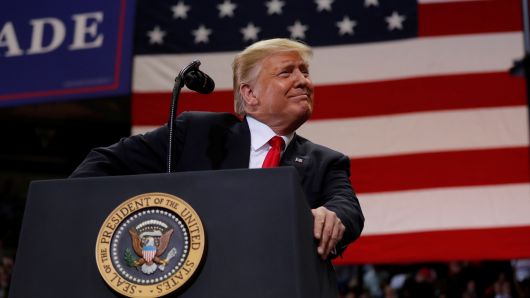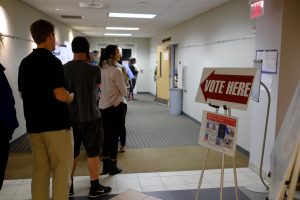Voting in the Midterm Elections : A Chance to Actually Make A Difference : A Well Thought Out Scream by James Riordan

More than 30 million Americans have cast early ballots ahead of Tuesday’s midterm elections, eclipsing the 2014 early totals nationally and suggesting a high overall turnout for contests that could define the final two years of President Donald Trump’s term. At least 28 states have surpassed their 2014 early votes. And perhaps even more indicative of the unusual enthusiasm this midterm cycle, some states are approaching their early turnout from the 2016 presidential election.
Republicans currently have the advantage in the United State Senate with a 51-49 majority. They are seeking to expand that with the primary battles for control occurring in states that President Trump won in 2016. There are thirty-five Senate contests happening on Tuesday. Ten of these involve Democratic incumbents seeking re-election in states that Trump won and the President has spent much of the week before the election campaigning in those states. The Democratic hopes of taking the Senate require almost all of their incumbents to win as well as winning seats in a few states that lean Republican, primarily Arizona, Tennessee and Texas.
The 30.6 million early ballots cast includes voters from 48 states. The early vote total in the 2014 midterm election was was 28.3 million in an election where more than 83 million Americans voted, a low turnout (about 36 percent) even by usual standards of a midterm, when there’s an expected drop off from presidential elections. Election forecasters are predicting that overall turnout this year could approach 50 percent, levels not seen for a midterm since the turbulent 1960s.
 Of course the big question is whether the Republicans will keep control of the Senate or whether the Democrats will gain enough seats to take over. Republicans also hold the majority of seats in the House of Representatives but the most recent polls suggest that Democrats have a grand opportunity to take back the House, the prognosticators say that Republicans will not only continue to control the Senate but actually gain seats.
Of course the big question is whether the Republicans will keep control of the Senate or whether the Democrats will gain enough seats to take over. Republicans also hold the majority of seats in the House of Representatives but the most recent polls suggest that Democrats have a grand opportunity to take back the House, the prognosticators say that Republicans will not only continue to control the Senate but actually gain seats.
In this Oct. 12, 2018 photo, former Vice President Joe Biden, left, and Democratic Sen. Joe Donnelly speak during a rally in Hammond, Ind. Republicans have a huge advantage as they seek to hold or expand their 51-49 Senate majority, with the battle for control running mostly through states that President Donald Trump won in 2016. (AP Photo/Darron Cummings
 In this Oct. 29, 2018 photo, Kentucky’s 6th Congressional District candidates Amy McGrath, left, Andy Barr, center, pose for photos before the start of a debate in Lexington, Ky. Barr, the Republican incumbent, faces a tough challenge from McGrath, a Democrat. The Lexington-area battle pits third-term Republican Rep. Andy Barr against Democrat Amy McGrath, a retired Marine fighter pilot. Trump won the 6th District by more than 15 percentage points in 2016. But with the help of carefully-shaped campaign ads that went viral, McGrath holds the edge on campaign fundraising.
In this Oct. 29, 2018 photo, Kentucky’s 6th Congressional District candidates Amy McGrath, left, Andy Barr, center, pose for photos before the start of a debate in Lexington, Ky. Barr, the Republican incumbent, faces a tough challenge from McGrath, a Democrat. The Lexington-area battle pits third-term Republican Rep. Andy Barr against Democrat Amy McGrath, a retired Marine fighter pilot. Trump won the 6th District by more than 15 percentage points in 2016. But with the help of carefully-shaped campaign ads that went viral, McGrath holds the edge on campaign fundraising.
In the Senate thirteen races are considered highly competitive. Out of those 13 races, eight states have a Democrat incumbent. However, six of those states voted for Donald Trump in the 2016 presidential elections. Republicans, on the other hand, have incumbents in five states. Four of those states voted for Mr Trump in 2016. To put it simply,  Democrats have more seats up for re-election than the Republicans, and the majority of these seats are in states that overwhelmingly in favour of Mr Trump in 2016. In fact, Trump won 10 out of 13 states with close Senate races. Statistical analysis website FiveThirtyEight predicts that Republicans have a 6 in 7 chance of keeping control of the Senate. There is 10 per cent chance they will win five more seats. Democrats face the same probability for netting two seats.
Democrats have more seats up for re-election than the Republicans, and the majority of these seats are in states that overwhelmingly in favour of Mr Trump in 2016. In fact, Trump won 10 out of 13 states with close Senate races. Statistical analysis website FiveThirtyEight predicts that Republicans have a 6 in 7 chance of keeping control of the Senate. There is 10 per cent chance they will win five more seats. Democrats face the same probability for netting two seats.
In this Oct. 30, 2018 photo, Democratic Sen. Joe Donnelly, left, shakes hands with Republican former state Rep. Mike Braun following a U.S. Senate Debate in Indianapolis. Republicans have a huge advantage as they seek to hold or expand their 51-49 Senate majority, with the battle for control running mostly through states that President Donald Trump won in 2016.
 In states that require party registration, Democrats have cast 41 percent of the early ballots, compared to 36 percent for Republicans. Party strategists on both sides say they are far exceeding their usual numbers in key locales — urban strongholds for Democrats and more rural counties for Republicans. Prognosticators caution that the party analysis isn’t always an indicator of final outcomes. There are crossover voters, even in this hyperpartisan era. And there are independents and third-party voters, as well. For the record, those latter groups account for about 23 percent of the ballots in party registration states.
In states that require party registration, Democrats have cast 41 percent of the early ballots, compared to 36 percent for Republicans. Party strategists on both sides say they are far exceeding their usual numbers in key locales — urban strongholds for Democrats and more rural counties for Republicans. Prognosticators caution that the party analysis isn’t always an indicator of final outcomes. There are crossover voters, even in this hyperpartisan era. And there are independents and third-party voters, as well. For the record, those latter groups account for about 23 percent of the ballots in party registration states.
For the scorekeepers, though, Virginia, among the states that doesn’t have party registration, is replicating its 2017 voting boom — and Democrats swept the top offices last year even amid strong GOP turnout.
The hotly-contested Senate races right now are in Texas, Tennessee, North Dakota and Florida. In Texas, there is a three-point gap between Democrat Congressman Beto O’Rourke and Republican incumbent Ted Cruz. Mr O’Rourke continues to inch closer with 47 per cent of likely voters and Mr Cruz with 50 per cent. Florida sees an even tighter race with Democrat incumbent Bill Nelson holding a two point lead (49 per cent) over his Republican challenger Rick Scott, the Sunshine State’s governor. As of right now, Tennessee leans Republican with incumbent Marsha Blackburn edging out former Democratic Governor Phil Bredesen with a 4-point lead. The most recent poll show 49 per cent of voters backing Mr Blackburn and 45 per cent for Mr Bredsend, which is a complete turnaround from a mid-September CNN poll when Mr Bredsend had a five-point lead.
It is no doubt that this is a high stake midterm election cycle. If Republicans do end up gaining more control over the Senate, there is one possible bright side: Democrats have a bit of advantage in 2020.
Republicans will be defending significantly more seats than Democrats with 22 seats up for re-election. Thus, providing Democrats will more chances to gain seats and play an offensive strategy to regain control over the Senate.
The 2018 midterm elections, as well as the one in 2020, will have long-term crucial ramifications for Americans and the country. The future of the Supreme Court, immigration reform, reproductive rights and health care all depends who wins the Senate — and by how much.
These days people are hotly debating their political preferences on Facebook and other forms of social media. Just remember all that means suat if you don’t get out and vote. VOTE IN THE MIDTERM ELECTIONS!








No Comment